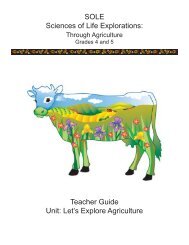Insect Anatomy - Agriculture in the Classroom
Insect Anatomy - Agriculture in the Classroom
Insect Anatomy - Agriculture in the Classroom
Create successful ePaper yourself
Turn your PDF publications into a flip-book with our unique Google optimized e-Paper software.
Student Worksheet 4<br />
Test Your Knowledge<br />
Answers:<br />
1.<br />
2.<br />
3.<br />
4.<br />
5.<br />
10<br />
Mosquito<br />
13<br />
A.) 2 B.) 4<br />
Fly - because it only has one pair of w<strong>in</strong>gs, and <strong>the</strong> o<strong>the</strong>rs have 2<br />
All flies have one pair of w<strong>in</strong>gs only. As students learn more about <strong>in</strong>sects, <strong>the</strong>y will beg<strong>in</strong> to look for<br />
some of <strong>the</strong>se parts of <strong>the</strong>ir anatomy that help describe <strong>the</strong>m. A very beneficial <strong>in</strong>sect called <strong>the</strong> hover<br />
fly eats <strong>in</strong>sect pests from flower<strong>in</strong>g plants. It resembles some bees or wasps, because of its color<strong>in</strong>g. But<br />
upon closer exam<strong>in</strong>ation, you can see it has one pair of w<strong>in</strong>gs. Understand<strong>in</strong>g and identify<strong>in</strong>g <strong>in</strong>sects<br />
helps you determ<strong>in</strong>e if it is a pest or a beneficial <strong>in</strong>sect and is an important part of <strong>in</strong>tegrated pest<br />
management.<br />
Student Worksheet 5<br />
How Many Legs does an <strong>Insect</strong> Have<br />
Students practice us<strong>in</strong>g a chart to re<strong>in</strong>force what <strong>the</strong>y are learn<strong>in</strong>g about <strong>in</strong>sect anatomy. Of <strong>the</strong> garden<br />
creatures depicted, only <strong>the</strong> butterfly, <strong>the</strong> ant, and <strong>the</strong> grasshopper are <strong>in</strong>sects. Spiders, ticks, millipedes<br />
and centipedes do not follow <strong>the</strong> rule of three pairs of legs. You may use this to cont<strong>in</strong>ue <strong>the</strong> discussion of<br />
bug vs. <strong>in</strong>sect.<br />
Student Worksheet 6<br />
What Does <strong>Anatomy</strong> Mean<br />
Us<strong>in</strong>g <strong>the</strong> six anatomy words given, students will label <strong>the</strong> body parts of <strong>the</strong> ladybug.<br />
Student Worksheet 7<br />
More <strong>Insect</strong> Parts!<br />
Students are asked to label <strong>the</strong> anatomy of <strong>the</strong> butterfly.<br />
Student Worksheet 8<br />
W<strong>in</strong>gs!<br />
The importance of <strong>in</strong>sect w<strong>in</strong>gs is that <strong>the</strong>y are passive - not directly moved by muscles but flapped by<br />
<strong>the</strong> compression of <strong>the</strong> thorax. Students may compare this to <strong>the</strong> human thorax, as <strong>the</strong> chest expands<br />
and contracts dur<strong>in</strong>g breath<strong>in</strong>g.<br />
The ladybug is a beetle with two pairs of w<strong>in</strong>gs. The forew<strong>in</strong>gs are rigid and protective and do not assist flight.<br />
The h<strong>in</strong>dw<strong>in</strong>gs are soft and flexible and are folded under <strong>the</strong> forew<strong>in</strong>gs for protection.<br />
Although it sometimes appears that <strong>in</strong>sect legs are attached to <strong>the</strong> abdomen, rem<strong>in</strong>d students that <strong>the</strong>y<br />
are always attached to <strong>the</strong> thorax.
















